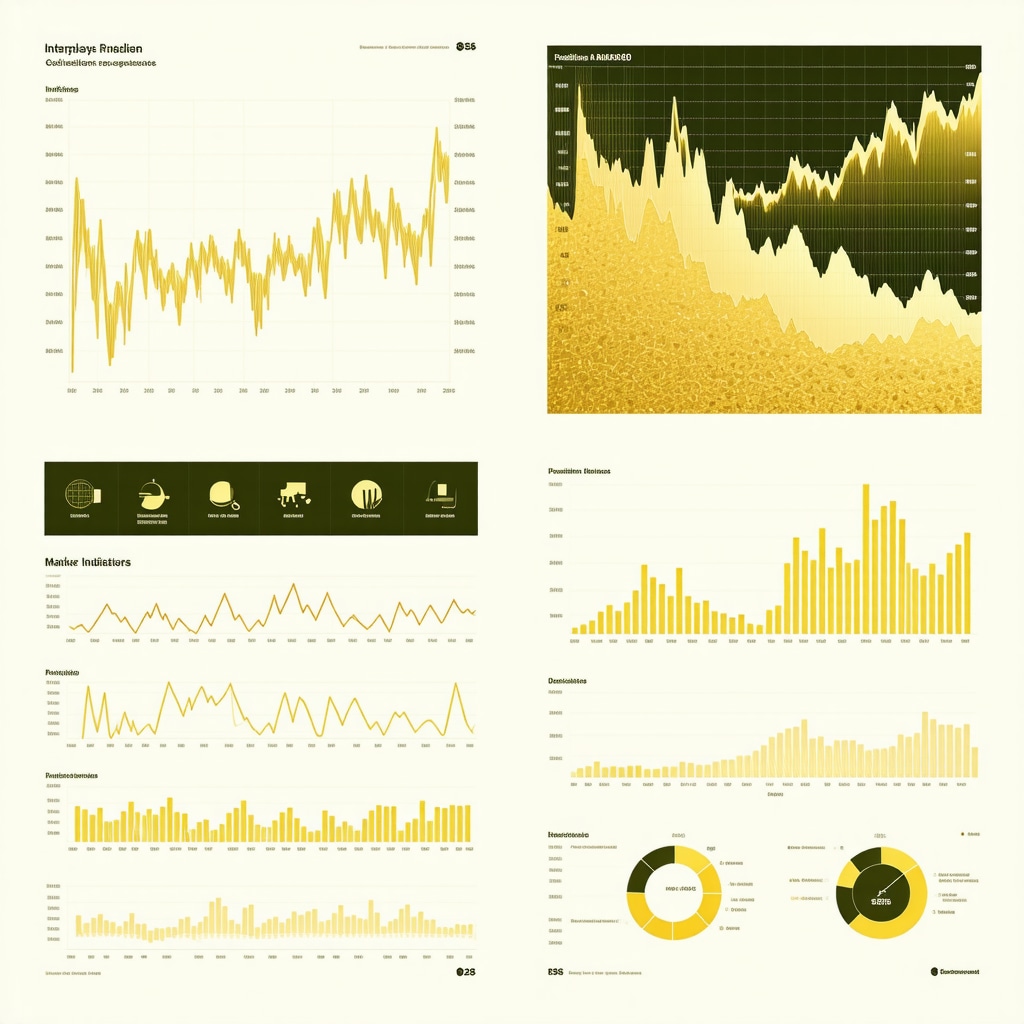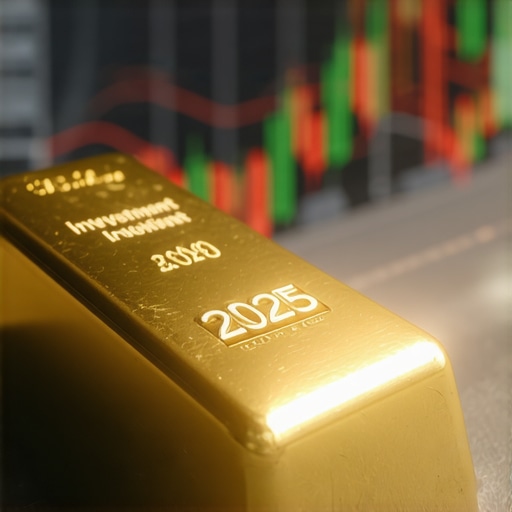Gold: The Timeless Inflation Fighter We Can’t Stop Talking About
It’s that time again—when inflation’s sneaky fingers seem to nibble away at your paycheck, and suddenly, the shiny allure of gold becomes more than just a jewelry obsession. If 2025 has taught us anything, it’s that protecting your wealth against inflation demands more than just crossing your fingers. Gold investment strategies aren’t just financial jargon; they’re a survival kit for the economically savvy. So, how do you turn your portfolio into a fortress against rising prices? Let’s dig in.
Why Gold Still Steals the Show in Inflation Hedging
Remember the 1970s? When inflation soared and gold prices skyrocketed, turning savvy investors into overnight heroes? Fast forward to 2025, and the narrative remains strikingly similar. Gold’s intrinsic value and scarcity make it an unmatched hedge against inflation. Unlike paper currencies that governments can print at will, gold’s supply remains relatively fixed, preserving purchasing power over time. This phenomenon is backed by decades of financial analysis, including insights from the World Gold Council, which highlights gold’s role as a safeguard during economic instability.
Is Buying Physical Gold Bars Still the Golden Standard?
Here’s the million-dollar question (or rather, the multi-thousand-dollar one): Should you dive into physical gold bars, coins, or opt for the convenience of gold ETFs and mutual funds? Physical gold offers tangible security, a comforting heft in your hand that digital assets can’t replicate. It’s a classic move, but requires careful storage and trusted dealers—check out our best practices for buying and storing gold bullion safely if you want to avoid rookie mistakes.
Diversify Like a Pro: Mixing ETFs, Mining Stocks, and Physical Gold
Modern portfolios often blend physical gold with gold ETFs and mining stocks for a diversified approach. ETFs offer liquidity and ease of trading, while mining stocks can add growth potential albeit with higher risk. Balancing these options can smooth out volatility and maximize returns. Curious how to build a balanced gold portfolio? There’s a handy guide on building a balanced gold portfolio with ETFs and stocks that’s worth a peek.
Keep Your Ear to the Ground: Market Trends Matter
Gold investment isn’t a set-it-and-forget-it affair. Staying informed about global economic shifts, central bank gold purchases, and supply-demand dynamics can give you a leg up. For instance, the surge in central bank gold buying in recent years has tightened supply, influencing prices upward. For a deep dive into how these factors shape the market, the analysis on central bank gold purchases is a must-read.
Ready to Spark a Conversation?
What’s your take on gold as the ultimate inflation hedge? Have you tried mixing physical gold with ETFs or stocks? Dive into the discussion below, share your stories, or ask your burning questions about gold investing strategies for 2025. After all, the best investment is the one where knowledge shines as brightly as the gold itself.
For more expert insights and actionable strategies, the World Gold Council offers authoritative resources that keep investors well-informed and confident in their gold ventures (World Gold Council).
Beyond Basics: How Geopolitical Shifts Influence Gold’s Inflation Hedge Role
Gold’s reputation as a dependable inflation hedge is well-deserved, but the story deepens when you consider the geopolitical turbulence shaping 2025. Trade tensions, currency fluctuations, and global conflicts can dramatically shift investor sentiment, often sending gold prices soaring as a safe haven asset. For instance, recent conflicts and economic sanctions have tightened gold supply chains, pushing prices upward while amplifying volatility. Savvy investors who monitor these developments gain a strategic advantage, adapting their portfolios to mitigate risks and capitalize on growth opportunities. To understand the fine details of these supply-demand dynamics, analyzing gold supply and demand for smart buying is crucial.
Mastering Gold Futures: A Sophisticated Tool for Inflation Hedging?
Gold futures contracts offer investors a way to hedge against inflation with more leverage and flexibility than physical gold or ETFs alone. Yet, this approach demands a nuanced understanding of market timing, margin requirements, and risk management. Unlike owning gold outright, futures require active monitoring and can amplify both profits and losses. For those with a high-risk tolerance and an appetite for trading, mastering gold futures could unlock superior returns. Beginners should tread carefully and consider educational resources such as our essential tips for new investors to navigate this complex terrain effectively.
How Can Investors Balance Gold’s Stability with Market Volatility in 2025?
This pivotal question challenges investors to blend gold’s traditional stability with the unpredictable nature of global markets. Should one prioritize physical gold’s security or leverage ETFs and futures for liquidity and growth? The ideal strategy often involves a calibrated mix tailored to one’s risk profile and investment horizon. Monitoring gold’s reaction to inflation indicators, central bank policies, and geopolitical risks enables investors to rebalance portfolios dynamically. Delving into expert analyses, such as those found in the expert analysis on gold price trends and forecast highlights for 2025, equips investors with critical insights for decision-making.
Environmental and Ethical Considerations: A New Dimension in Gold Investing
Increasingly, investors are factoring in the environmental and ethical impact of gold mining. Sustainable practices and responsible sourcing not only influence corporate reputations but also affect long-term investment viability. Mining companies prioritizing eco-friendly operations and fair labor practices often demonstrate resilience amid regulatory changes and social scrutiny. The World Gold Council emphasizes these trends, encouraging investors to consider ESG (Environmental, Social, and Governance) criteria alongside financial metrics. This approach aligns wealth growth with global responsibility, adding a layer of conscientiousness to gold investment strategies (World Gold Council on Sustainability).
Maximizing Returns: Combining Gold with Complementary Assets
While gold shines as a hedge, pairing it with assets like inflation-protected securities or diversified commodities can enhance portfolio resilience. This synergy helps cushion against inflation while capturing growth in different market cycles. For investors seeking a comprehensive blueprint, exploring top gold investment strategies to protect and grow wealth offers valuable guidance on crafting balanced, inflation-resistant portfolios.
Join the Discussion: What’s Your Gold Investment Strategy for 2025?
Are you leveraging physical gold’s security, tapping ETFs for agility, or engaging with futures for higher stakes? Share your experiences, strategies, or questions in the comments below. Engaging with a community of informed investors sharpens your approach and unlocks fresh perspectives. Don’t forget to share this detailed exploration with fellow investors aiming to navigate 2025’s inflationary landscape effectively.
Strategic Gold Allocation: Leveraging Macro-Economic Indicators for Superior Inflation Protection
To truly harness gold’s inflation-hedging prowess in 2025, investors must integrate macroeconomic signals into their allocation strategies. Variables such as real interest rates, currency depreciation trends, and central bank monetary policies are pivotal. For example, negative real yields typically correlate with rising gold prices, as holding non-yielding assets becomes comparatively attractive. Advanced portfolio managers utilize econometric models to decipher these relationships, optimizing gold weightings dynamically rather than adhering to static allocations. This tactical approach not only mitigates inflation risk but also enhances overall portfolio resilience in volatile environments.
Decoding the Nuances of Central Bank Gold Reserves: Implications for Inflation and Portfolio Diversification
Central banks have been quietly reshaping the gold landscape, increasingly diversifying reserves away from traditional dollar-denominated assets. Their strategic acquisitions, particularly by emerging economies seeking to hedge against dollar volatility and geopolitical tensions, exert upward pressure on gold prices. Understanding the timing, scale, and geopolitical motives behind these purchases can provide investors with unique alpha opportunities. For instance, tracking the quarterly disclosures of the International Monetary Fund (IMF) and national reserve banks offers critical insights into forthcoming market shifts. Investors equipped with this intelligence can anticipate supply-demand imbalances and adjust their positions proactively.
What Advanced Metrics Best Predict Gold Price Movements in Complex Inflationary and Geopolitical Contexts?
While traditional indicators like inflation rates and interest yields remain foundational, more sophisticated metrics have emerged to forecast gold’s trajectory amid 2025’s complexity. These include the Gold-Oil ratio, which reflects inflationary pressures linked to energy costs, and the Geopolitical Risk Index (GPR), quantifying uncertainty that drives safe-haven flows. Additionally, analyzing central bank reserve changes via the IMF’s International Financial Statistics offers real-time supply-demand insights. Combining these with machine learning models enables nuanced predictions, empowering investors to pre-empt market moves rather than react post-factum.
Sustainable Gold Investing: Integrating ESG Metrics Without Sacrificing Returns
Environmental, Social, and Governance (ESG) considerations are no longer peripheral; they are central to sophisticated gold investing. Investors are now scrutinizing mining firms’ carbon footprints, water management policies, and community engagement initiatives. Companies committed to responsible sourcing often demonstrate operational efficiencies and regulatory resilience that translate into stable long-term cash flows. Incorporating ESG scores into quantitative models can identify underappreciated assets poised for outperformance. The World Gold Council’s sustainability framework provides comprehensive criteria and case studies, guiding investors through this evolving dimension of gold investment.
Advanced Hedging Techniques: Combining Gold Futures, Options, and Physical Holdings
Beyond basic gold futures, integrating options strategies can finely tune inflation hedges by managing downside risk and capitalizing on volatility premiums. For instance, purchasing protective puts alongside holding physical gold can safeguard portfolios during abrupt inflation spikes or geopolitical shocks. Moreover, calendar spreads in futures markets allow investors to exploit term structure anomalies reflecting market expectations for inflation trajectories. Mastery of these instruments demands rigorous risk management frameworks and a deep understanding of derivatives pricing models, but the payoff is a highly customizable inflation defense mechanism.
Engage with Experts: Elevate Your Gold Investment Strategy Today
Are you ready to refine your gold allocation with cutting-edge insights and tools? Join our expert-led webinars and discussions where we dissect 2025’s inflation dynamics, geopolitical risks, and ESG integration in gold investing. Share your strategies and challenge conventional wisdom to foster a community of forward-thinking investors. Remember, in the intricate dance between inflation and gold, knowledge is your most valuable asset.
Deciphering the Interplay Between Gold and Inflation Expectations
In the intricate dance of macroeconomics, gold’s price movements often mirror shifts in inflation expectations rather than inflation alone. Sophisticated investors recognize that anticipated inflation, gauged through instruments like Treasury Inflation-Protected Securities (TIPS) breakeven rates, can signal turning points for gold demand. When market participants foresee rising inflation, gold’s role as a protective asset intensifies, nudging prices upward ahead of actual inflationary pressures. This anticipatory behavior underscores the importance of monitoring real-time inflation forecasts alongside traditional economic indicators to strategically time gold acquisitions.
How Do Inflation-Linked Bonds Complement Gold in a Modern Inflation Hedge?
Inflation-linked bonds, notably TIPS in the U.S. and similar instruments globally, provide a fixed-income complement to gold’s non-yielding nature. While gold offers capital preservation and a store of value under monetary debasement, inflation-linked bonds deliver coupon payments that adjust with inflation, providing steady income streams. A hybrid allocation combining these assets can balance growth, liquidity, and risk mitigation. For investors keen to explore this synergy, our top gold investment strategies to protect and grow wealth offers nuanced frameworks for portfolio construction.
Quantitative Models and Machine Learning: The Frontier of Gold Price Forecasting
The complexity of 2025’s economic landscape invites the application of advanced quantitative techniques to decode gold’s price trajectory. Machine learning algorithms, trained on multifactor datasets including real interest rates, geopolitical risk indices, and commodity price correlations, enable predictive analytics that surpass traditional econometric models in accuracy. Financial institutions increasingly leverage these tools to detect subtle market signals and anticipate volatility spikes, positioning gold strategically within diversified portfolios. For those interested in the cutting edge of gold market analysis, refer to the comprehensive 2025 gold price forecast experts reveal key market signals.
Integrating Gold’s ESG Credentials into High-Performance Investment Mandates
Environmental and ethical scrutiny is reshaping investor priorities, with gold mining companies under heightened pressure to demonstrate sustainable practices. Leading firms incorporate renewable energy, water conservation, and community engagement into their operational ethos, translating ESG commitment into tangible risk reduction and brand value. Investors who embed ESG metrics into their gold selection criteria not only align with evolving regulatory landscapes but may also capture alpha through exposure to resilient companies. Industry leaders like Newmont and Agnico Eagle are frequently cited for exemplary ESG integration, as detailed in authoritative analyses by the World Gold Council’s sustainability framework.
What Role Does ESG Investing Play in Shaping Gold Mining Stocks’ Risk-Return Profiles?
ESG investing fundamentally alters the risk calculus for gold mining equities. Mining operations with poor environmental practices face regulatory sanctions, community opposition, and reputational damage, which translate into financial underperformance. Conversely, companies with strong ESG credentials often enjoy preferential access to capital, smoother permitting processes, and improved operational efficiency. Detailed ESG scoring models enable investors to differentiate between superficially greenwashed entities and genuinely sustainable operators. For a deep dive into balancing risks and rewards in gold mining stocks, explore our investing in gold mining stocks risks and rewards explained.
Dynamic Portfolio Adjustments: Responding to Inflation Surprises with Tactical Gold Weighting
Static gold allocations can leave portfolios vulnerable to inflation surprises or rapid shifts in market sentiment. Adaptive strategies advocate for dynamic weighting of gold based on leading inflation indicators and geopolitical developments. For example, an unexpected spike in commodity prices or a sudden escalation in geopolitical risk might prompt increasing gold exposure tactically. This approach demands robust risk management and real-time market intelligence but can significantly enhance inflation protection effectiveness. Investors can learn more about constructing responsive portfolios in our detailed guide on top gold investment strategies to protect and grow wealth.
Join the Conversation: How Are You Navigating Gold Investing Amid Evolving Inflation Dynamics?
We invite you to share your perspectives on blending traditional gold holdings with innovative inflation-hedging instruments. Are you integrating ESG criteria into your gold investment decisions? How do you adjust your gold allocation in response to real-time economic signals? Join the discussion below or connect with our expert community to exchange strategies and insights. For those eager to deepen their understanding, our investing in gold for beginners top tips to start now offers foundational knowledge, while advanced investors can explore tactical guides and market analyses featured throughout our site.
For authoritative data and ongoing market intelligence, the World Gold Council remains an indispensable resource for discerning investors.

Expert Insights & Advanced Considerations
Gold’s Dynamic Role Beyond Traditional Inflation Hedging
While gold is conventionally seen as a static inflation hedge, 2025 underscores its evolving function as a tactical asset responsive to real-time macroeconomic shifts. Investors must appreciate gold’s sensitivity not only to inflation data but also to inflation expectations and geopolitical risk indices, enabling more agile portfolio adjustments.
Integrating ESG Metrics Without Compromising Returns
The modern investor faces the challenge of aligning sustainability with profitability. Incorporating Environmental, Social, and Governance (ESG) criteria into gold investments—especially mining stocks—can mitigate regulatory and reputational risks while identifying companies poised for resilient long-term growth. This nuanced approach requires advanced screening beyond headline ESG claims.
Leveraging Quantitative Models and Machine Learning for Market Forecasts
Predictive analytics powered by machine learning provide a competitive edge in anticipating gold price movements amid complex inflationary and geopolitical landscapes. These models synthesize diverse data streams—ranging from real interest rates to geopolitical risk indices—offering sophisticated insights that outpace traditional forecasting methods.
Strategic Use of Derivatives to Customize Inflation Protection
Advanced investors can enhance their hedging strategies by combining gold futures and options with physical holdings. This layered approach enables tailored risk management, capturing volatility premiums while limiting downside exposure, thereby creating a refined inflation defense mechanism adaptable to market fluctuations.
Adaptive Portfolio Weighting Based on Leading Economic Indicators
Static gold allocations fall short in volatile environments. Employing dynamic weighting strategies informed by leading indicators such as commodity price spikes and central bank policies allows investors to tactically enhance gold exposure, optimizing inflation protection and portfolio resilience.
Curated Expert Resources
- World Gold Council (gold.org): The definitive source for comprehensive data, sustainability frameworks, and market insights crucial for advanced gold investing decisions.
- BuyingGoldNow’s Top Gold Investment Strategies (top gold investment strategies to protect and grow wealth): A detailed blueprint for crafting diversified, inflation-resilient portfolios integrating physical gold, ETFs, and mining stocks.
- 2025 Gold Price Forecast Experts Reveal Key Market Signals (2025 gold price forecast experts reveal key market signals): Advanced market analysis leveraging cutting-edge forecasting techniques for anticipating price movements.
- Mastering Gold Futures Trading: Essential Tips for New Investors (master gold futures trading essential tips for new investors): A practical guide to navigating the complexities of futures and options as part of a sophisticated inflation hedge.
- Investing in Gold Mining Stocks: Risks and Rewards Explained (investing in gold mining stocks risks and rewards explained): Insightful analysis of ESG integration and financial risk considerations within the mining sector.
Final Expert Perspective
Gold’s enduring reputation as the quintessential inflation hedge is well earned, yet 2025 challenges investors to adopt a more sophisticated lens. The interplay between inflation expectations, geopolitical volatility, and ESG imperatives demands strategies that are both flexible and grounded in deep market intelligence. By integrating advanced quantitative tools, dynamic portfolio management, and sustainable investment principles, one can harness gold’s full potential to safeguard and grow wealth in uncertain times. To deepen your expertise and tailor your approach, explore nuanced strategies and practical guides like top gold investment strategies to protect and grow wealth and engage actively with expert communities. Remember, in the realm of gold investing, knowledge not only protects your capital—it illuminates it.










